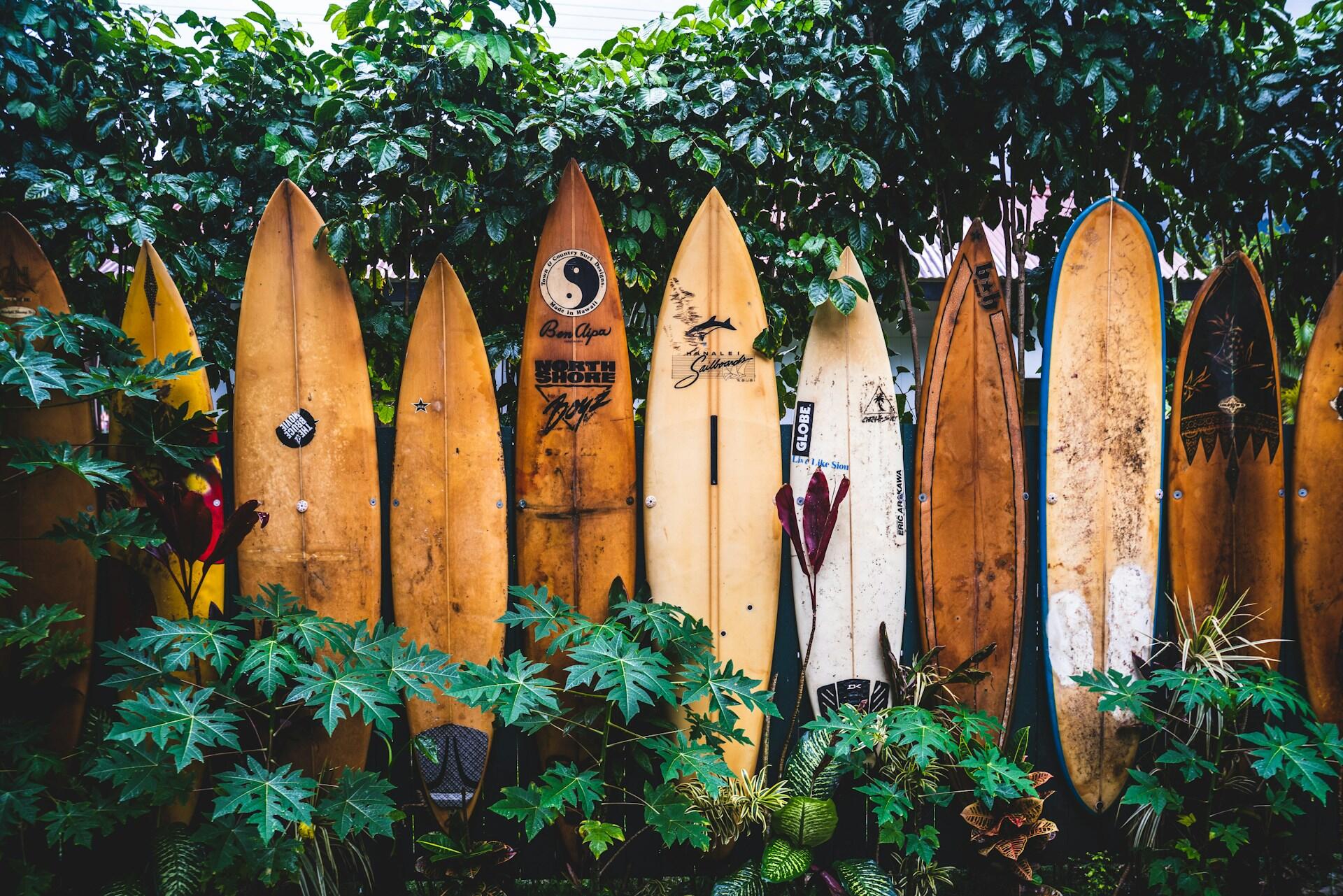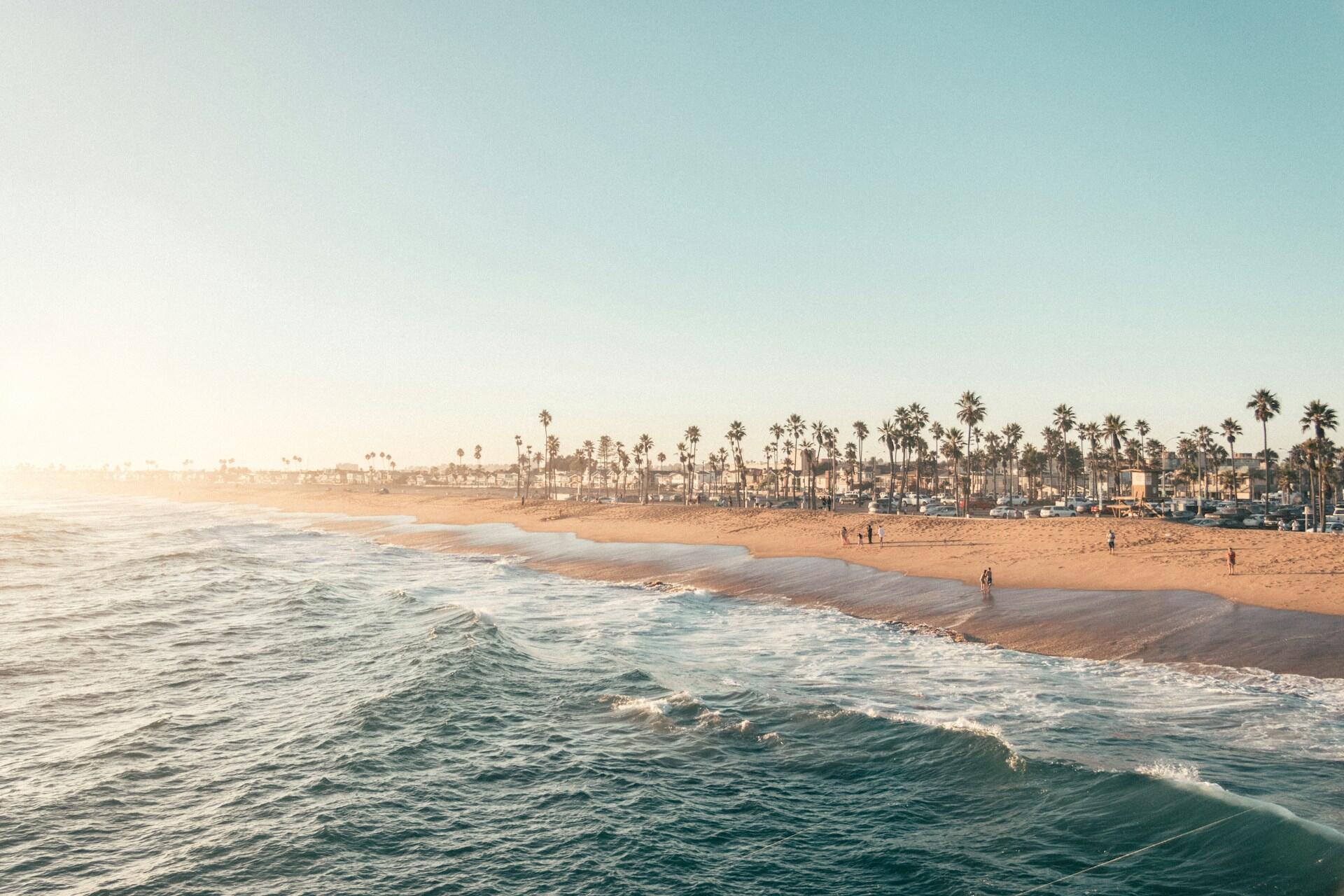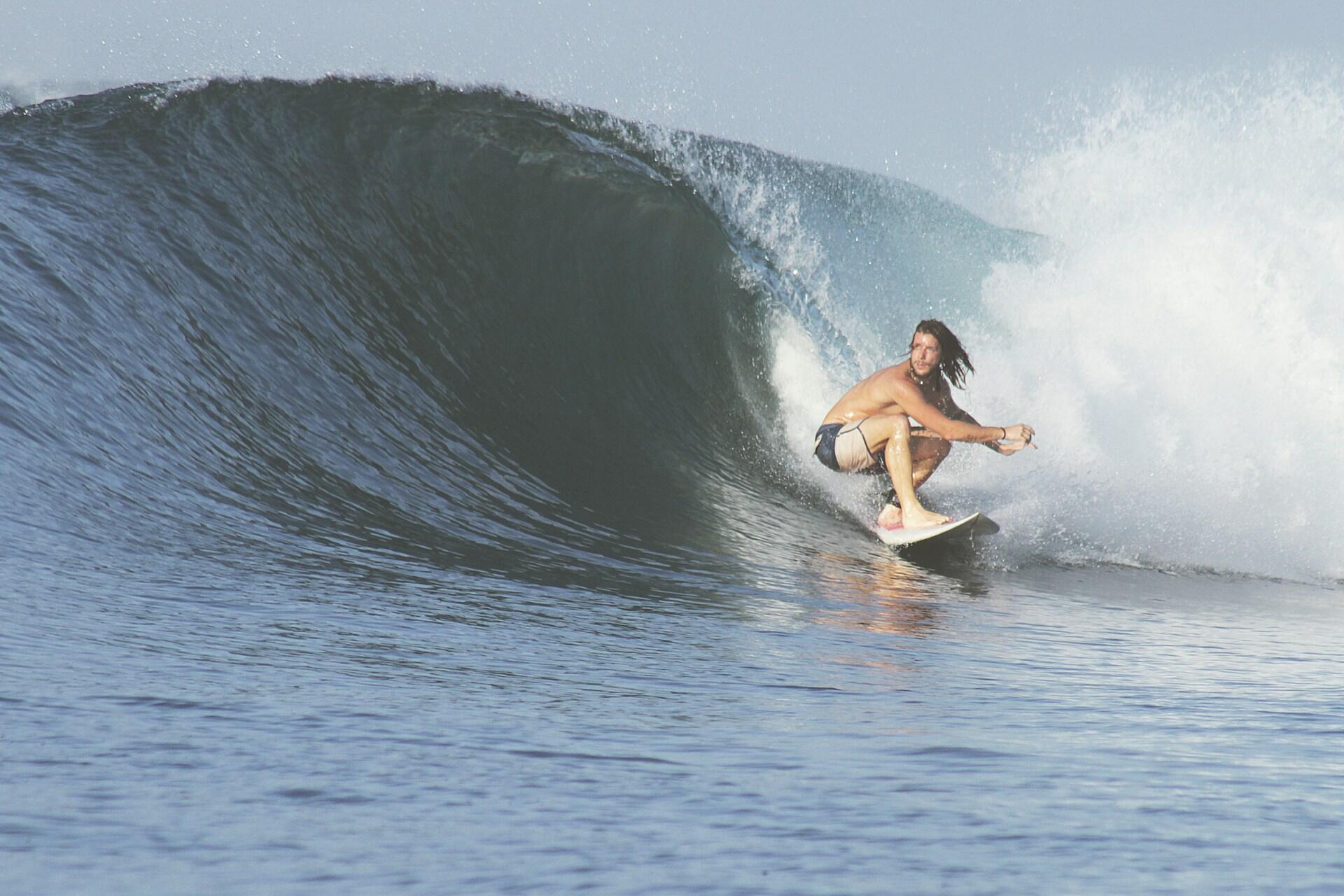Surfing has evolved significantly from its early roots. From a sacred ritual in the Pacific Islands to a global competitive sport, it's taken the world by storm. Here's how surfing went from a deeply spiritual connection to the ocean to an Olympic event.

Origins of Surfing in Polynesia
The origins of surfing go back years. On the islands of ancient Polynesia, surfing was more than just a pastime; it was a sacred cultural tradition. Some of the earliest known ancient surfing practices involved Polynesians riding waves on wooden boards carved from local koa trees, among others. These boards would vary in size and shape, with some reaching over 4 metres in length, and would be tailored to the surfer's status and skill.

Surfing was closely tied to ritual, identity, and the rhythms of the ocean, making Polynesian surfing history deeply spiritual. The chiefs would have the best boards, and surfing was partly a way to honour the ocean, demonstrate agility and prowess, and connect with the gods.
It's difficult to say precisely when surfing was invented, but archaeological evidence and oral traditions suggest that its earliest forms started at least 1,000 years ago. Polynesian cultures were likely the true inventors of surfing and probably the first to formally ride waves for both pleasure and privilege. Surfing spread across island communities from Tahiti to Samoa, eventually making its way to Hawaii, where it became a central part of everyday life.
Surfing originated over 1,000 years ago in ancient Polynesia. It was a sacred practice involving social status, ritual, and nature.
Surfing in Hawaii
Surfing spread across the Pacific and to Hawaii. Polynesian settlers arrived in the Hawaiian Islands between 500 and 1300AD. During that time, they would have likely brought early versions of their wave-riding traditions.
There's evidence from the 12th century showing people riding waves in cave paintings. In Hawaii, chiefs (ali'i) would ride the longest boards, some of which were over 5 metres in length. It was common for these boards to be made from sacred woods, such as koa or wiliwili. Commoners would ride shorter boards, such as alaia, which typically measured between 2.5 and 4 metres. Following a traditional kapu system, they would ride less prominent breaks. Building a surfboard was a highly spiritualised process, with the chosen tree felled with care before being blessed by priests (kahuna) and shaped using stone and coral tools.

Hawaiians didn't just ride waves; they studied them. Their knowledge of wave patterns, wind, and reef structure was passed down orally, and surfers could wait days or weeks for the right conditions.
The first written account of surfing was from Lieutenant James King in 1779. He observed native Hawaiians surfing skillfully on waves, but Christian missionaries on the island viewed surfing and any aspects of Hawaiian religion as immoral, with many traditional practices, including surfing, suppressed.

Surfing Reaches the West
Following Captain Cook's third voyage, during which he observed Native Hawaiians riding waves off the coast of the Big Island in 1779, surfing didn't immediately reach the West. As mentioned, the suppression of indigenous cultures by the West extended beyond religion and included other spiritual practices like surfing.
Surfing was largely unknown outside of Polynesia for over a century, and it was only in the 20th century that it would gain popularity in North America and Australia. One of the first surfers to bring surfing to the American mainland was George Freeth. A part-Hawaiian surfer of Irish descent was invited to California in 1907 to demonstrate wave riding and lifeguard techniques with his shorter, more maneuverable board.
Exhibitions in Redondo Beach and Venice Beach marked the beginning of surfing in the continental United States. Freeth's boards were significantly shorter than the traditional Hawaiian olo, sparking the evolution of shorter, lighter boards that allowed for greater control and agility on waves.
Surfing's breakout came with Duke Kahanamoku. The Hawaiian Olympic gold medallist swimmer travelled as a sports ambassador and famously visited Australia in 1914. Using a 2.6-metre wooden surfboard that he made from local sugar pine, he demonstrated surfing at Freshwater Beach in Sydney. To say Australians loved it would be an understatement. The "official" introduction of surfing in Australia wasn't actually the first time surfing was done in Australia, though. There's evidence to suggest that early bodysurfing and primitive board riding had existed in coastal towns like Manly and Yamba before Duke arrived.
That said, Duke's influence inspired locals like Isabel Letham, who surfed tandem with him. The effect of the visit and demonstration would be felt across New South Wales and beyond.
Surfing began to grow in Australia, New Zealand, and California, with communities of surfers drawn to the waves. Boards were still heavy and hard to transport, weighing up to 45 kg, but that didn't stop people from enjoying the thrill of riding waves.
The Californian Boom and Global Popularisation
By the mid-20th century, surfing had evolved from a niche Polynesian tradition into a rapidly growing sport. This was best seen in California, with post-war prosperity, a booming youth population, and the vast coastlines of the state, which made surfing a lifestyle and an industry.
California's beaches were ideal for surf culture. Local beach communities embraced the carefree, ocean-centred life, with Malibu, Huntington Beach, and Santa Cruz becoming meccas for new generations of Californian surfers.

Surf movies like Gidget (1959) and surf rock music from bands like The Beach Boys made surfing a mainstream, fun, and youthful rebellion against conformity. Magazines like Surfer, founded in 1960, covered surf technique, culture, lifestyle, and travel destinations.
Parallel Growth in Australia
Meanwhile, across the Pacific, Australia was also enjoying its own surf revolution. While not as globally popularised as California's with movies and music, coastal towns like Byron Bay, Noosa, Torquay, and Bells Beach were hotspots for surfers.
Australian surfboard design began to diverge from Hawaiian and Californian longboard traditions, with locals like Bob McTavish and George Greenough pioneering shorter and more agile boards, which led to the shortboard revolution and later, many different types of surfing.
Australia quickly established itself as a force to be reckoned with in the world of surfing. The rugged and varied coastline provided consistent swell conditions and served as a training ground for elite-level talent. Competitions, clubs, and professional sponsorships emerged.
Accessible air travel in the 1960s and 1970s enabled surfers from California and Australia to travel to Indonesia, South Africa, France, and South America, where they could find uncrowded waves.
By the end of the 20th century, surfing had become a global phenomenon, with regional surf cultures existing on every continent and coastline.
500–1300 AD
Polynesian Settlers Bring Surfing to Hawaii
Surfing evolved in Hawaii with specific board types and ritualistic practices. Chiefs rode the longest boards and followed strict traditions.
1779
First Western Account of Surfing
Lt. James King documents surfing in Hawaii, though missionaries later suppress the practice.
1907
George Freeth in California
Demonstrates wave riding and lifeguarding. Helps spark U.S. interest in surfing.
1914
Duke Kahanamoku Visits Australia
Duke’s demo at Freshwater Beach launches modern surfing in Australia.
1950s–1960s
Post-War Surf Boom
Surfing spreads rapidly through California and Australia. Surf culture becomes mainstream.
Late 1960s
Shortboard Revolution
Australia leads innovation in board design, making surfing more dynamic.
2020
Surfing Becomes an Olympic Sport
Surfing debuts at the Tokyo Games, solidifying its place as a global competitive sport.
Evolution of Equipment and Surfboard Design
Though surfing may seem quite simple at first glance, the surfboard itself tells a story of innovation, experimentation, and revolution. In ancient surfing practices, the boards were solid wooden slabs, but have since evolved into high-performance boards ridden by elite surfers looking to enjoy all the surfing benefits.

Traditional Hawaiian Boards
The first boards in Polynesian surfing history, and particularly in Hawaii, were carved from hardwoods such as koa, wiliwili, or ulu (breadfruit). There were two main common boards:
The Redwood Era
Board builders in California in the 1900s used redwood, which was readily available in the area. However, this was still rather heavy, with surfboards weighing 40 to 50 kg, which made them very difficult to manoeuvre and transport.
and were made of redwood.
Experiments in the 1920s and 1930s led to the development of hollow board designs that utilised internal bracing and lighter wood to reduce weight while maintaining strength.
Fibreglass and Foam Revolution
The introduction of polyurethane foam cores and fibreglass coatings in the 1940s and 1950s made boards lighter, more flexible, and easier to produce in large quantities. These shifts marked the beginning of the modern surfing revolution, with more people than ever able to take up the sport of surfing.
The Shortboard Revolution
In the late 1960s, Australia played a significant role in reshaping board design. Bob McTavish and the Californian George Greenough introduced much shorter boards. At around 2 to 2.5 metres, these boards allowed for sharper turns and more aggressive surfing. With the change in boards came a shift in surfing style.
Led by Australia in the 1960s, shorter, more agile surfboards redefined modern surfing styles.
Innovation Today
Nowadays, modern surfboards utilise materials such as carbon fibre, epoxy resins, and computer-aided design. There are also dozens of different styles from longboards and fish boards to high-performance shortboards, tow-in boards for big wave surfing, and soft-top foam boards for beginners. Just make sure you know the rules of surfing if you're heading out as a beginner.
Competitive Surfing and Professionalisation
Surfing has now evolved from a sacred Polynesian cultural tradition to a sport, complete with competitions. In fact, competitive surfing (in the organised sense) has been going on for nearly a century. The first modern surf contest was likely the Pacific Coast Surf Riding Championships in California in 1928. However, these events were small and informal.
Australia really took to competitive surfing in the 1950s and 1960s during the post-war surf boom. The Australian National Titles helped establish the country as a global force in surfing, with Bells Beach in Victoria becoming an iconic venue, hosting what is now the Rip Curl Pro.
At the Tokyo 2020 Olympic Games, surfing was recognised as an Olympic event, with the sport also being part of the Paris 2024 Olympic Games. Surfers took to the waves in Tahiti, halfway around the world from the host city of Paris.
Check out the Olympics Surfing.
Now, whether you're surfing for fun or looking to do it competitively, you know where surfing came from and how it became the sport we know it as today.















